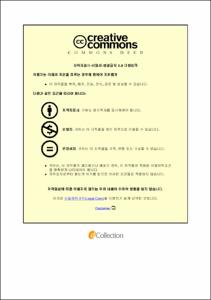Ulsan Univ. Repository
Thesis
General Graduate School
Environmental Construction Engineering
1. Theses (Master)
바이오차 기반 나노 망간 산화물과 주석 함유물을 이용한 유기오염물질의 환원처리
- Abstract
- 본 연구에서는 바이오차 기반 나노 망간 산화물과 주석 함유물을 이용하여 유기오염물질을 환원처리를 통해 제거하고자한다. 커피 바이오차에 나노 망간 산화물을 코팅하여 바이오차의 흡착제 역할과 나노 망간 산화 물의 환원제 역할을 통해 유기오염물질을 효과적으로 제거할 수 있음을 가정하였다. 또한 리튬이온배터리에서 음극물질만 추출하여 갈아 만든 cathode powder와 주석 함유물을 이용하여 단일 또는 두 가지을 섞어 사용하여 환원제 및 흡착제로서의 사용가능성을 평가하였다. 유기오염물질로 항생물질 및 방균제로 쓰이는 triclosan, 니트로화합물인 2,4-dinitrotoluene (DNT), 할로겐화 페놀류인 2,4-dichlorophenol (DCP)과 독성 음이온물질인 셀레늄과 크롬, 총 5가지 오염물질을 선정 하였다. 그리고 바이오차 기반 나노 망간 산화물로 2wt% nano MnO2-biochar, 3wt% nano MnO2-biochar, 그리고 주석 함유물로 tin (Sn(0)), tin(Ⅱ) oxide (SnO), tin(Ⅱ) chloride (SnCl2), 그리고 음극 물질인 cathode powder, 총 6가지 시료들을 사용하여 환원제 및 흡착제 로서의 사용가능성과 오염물질의 제거가능성을 평가하였다. 환원실험 결과로 triclosan의 경우, 바이오차 기반 나노 망간산화물이 커피 바이오차에 비해 제거율이 1~3% 정도 뛰어나다는 것을 알 수 있 었다. 또한 흡착 및 환원처리, 두 가지 방법으로 제거된다는 것을 확인 하였다. 주석함유물의 경우, 양을 늘려도 제거율 50~60%에 멈추었다. 이는 주석함유물 주위에 패시베이션 레이어 (passivation layer)가 생겨 더 이상 반응하지 않아 제거율이 멈춘 것으로 판단되었다. DCP의 경우에도, 바이오차 기반 나노 망간산화물이 커피 바이오차에 비해 제거율이 20% 이상 뛰어나다는 것을 알 수 있었으며 이는 흡착 및 환원처리, 두 가지 방법으로 제거된다는 것을 확인하였다. 혼합하여 사용할 시 cathode powder와 SnCl2의 혼합이 제거율이 45%로 가장 효과적이었다. 주석함유물과 cathode powder의 경우, solution에 HEPES buffer를 사용하여 pH를 조절하지 않은 실험이 조절한 실험에 비해 제 거율이 20% 증가하며 제거효율이 뛰어나다는 것을 알 수 있었다. DNT의 경우, 커피 바이오차만 이용한 실험보다 바이오차 기반 나노 망간 산화물을 사용한 실험이 제거율이 5% 정도 높다는 것을 알 수 있 었다. 또한 바이오차 기반 나노 망간 산화물에 추가적으로 환원제인 DTT를 섞은 결과는 바이오차 기반 나노 망간 산화물만 사용하였을 때 보다 제거율이 5~10% 증가하였다는 것을 알 수 있었다. Selenate 및 chromate의 경우, 독성 음이온물질의 제거율은 pH와 관련이 있음을 확인하였다. 독성 음이온물질의 경우, 용액의 pH가 물질의 pzc보다 높으면 탈 양자화로 인해 물질의 표면이 음(-)이 된다. 반면 용액의 pH가 물질의 pzc보다 낮을 경우 물질의 표면이 양으로 바뀌어 제거율이 증가될 것으로 판단되었다. Solution의 pH를 4로 낮추고 실험 한 결과, SnCl2를 제외한 Sn(0), SnO와 cathode powder는 제거율이 selenate에서 1~2%, chromate에서 5% 증가하였다. 따라서 독성 음이 온물질을 제거할 때, 용액의 pH와 물질의 pzc를 비교하면 제거효율을 높일 수 있다.|This study aimed to remove organic contaminants using biochar-based nano-manganese oxide and tin-containing materials. It was assumed that organic contaminants could be effectively removed through the adsorption of biochar and the reduction by nano-manganese oxides-biochar composites. Two types of biochar-based nano-manganese oxides (2wt% nano MnO2-biochar and 3wt% nano MnO2-biochar), 3 types of tin-containing materials (Sn(0), SnO, and SnCl2), and cathode power were evaluated for the removal of triclosan, 2,4-dinitrotoluene (DNT), 2,4-dichlorophenol (DCP), and toxic anions (selenate and chromate). The removal rate of triclosan by biochar-based nano manganese oxides was 1 to 3 percent higher than that of coffee biochar. It was found that the removal was due to adsorption and reduction reactions. Even if the amount of tin-containing materials increases, the removal rate was 50~60%. The removal rate was stopped due to the formation of passivation layers on the surface of tin-containing materials. In the case of DCP, biochar-based nano manganese oxides had a
higher removal rate than coffee biochar by about 20%. It could also be found that adsorption and reductive reactions were responsible for the removal of DCP. The removal rate of DCP by the mixture of cathode powder and SnCl2 was the most effective showing 45%. In the case of mixture of tin-containing materials and cathode powder, the removal rate was about 20 percent higher than that of tin-containing materials. The removal rate of DNT by biochar-based nano manganese oxides was about 5 percent more effective than that of coffee biochar. In addition, the results of the reductive experiment with biochar-based nano manganese oxides and reducing agent (DTT) were found to be 5~10% more effective than those without DTT. In the case of selenate and chromate, the removal rate was related to pH. When the pH of the solution was reduced from neutral pH to 4, the removal of selenate and chromate was enhanced by 1~2% and 5%, respectively. Our results suggest that biochar-based nano manganese oxide and tin-containing materials could may effectively remove contaminants via sorption and reduction reactions.
- Issued Date
- 2022
- Awarded Date
- 2022-02
- Type
- dissertation
- Affiliation
- 울산대학교
- Department
- 일반대학원 건설환경공학과 친환경산업에너지자원융합전공
- Advisor
- 오석영
- Degree
- Master
- Publisher
- 울산대학교 일반대학원 건설환경공학과 친환경산업에너지자원융합전공
- Language
- kor
- Rights
- 울산대학교 논문은 저작권에 의해 보호 받습니다.
- Appears in Collections:
- Environmental Construction Engineering > 1. Theses (Master)
- 파일 목록
-
-
Download
 200000605943.pdf
기타 데이터 / 1.44 MB / Adobe PDF
200000605943.pdf
기타 데이터 / 1.44 MB / Adobe PDF
-
Items in Repository are protected by copyright, with all rights reserved, unless otherwise indicated.